A friend asked me how to know when to pick the tangerines from his tree. My first thought was, it’s obvious, you pick them when they taste good. But then I remembered that for some people gardening is full of rights and wrongs; he was afraid there was a correct or incorrect time to pick his tangerines.
There’s no such thing.
“Are the fruit mostly orange?” I asked.
“Yeah.”
“Then taste one.”
“I have.”
“Did it taste tart? Did it taste OK?”
“It tasted good, definitely not tart.”
“Then it’s time.”
Color: the weak indicator
We had been surfing during that terse exchange, but we don’t have to shout in between waves here. So let’s get nuanced, botanical, even maybe philosophical.
Part of the maturing process of oranges and tangerines in Southern California is that they eventually fade their rind color from green to orange. No sweet oranges or tangerines that I know of will be ripe in our climate before they’ve turned orange. So once they’ve changed color, you can consider giving them a pick and taste.
However, it’s true that some varieties turn orange long before they taste sweet. Take the Gold Nugget mandarin, for example. It’s a “late-season” mandarin. Here is a photo I took of my tree on January 15.
Orange fruit: they look ready. But they were still pretty sour on this date. Gold Nuggets from this tree don’t taste sweet until March at the earliest. So the rind color is something of an indicator of maturity, but its not directly linked to how sweet the inside is.
What causes the rind to turn orange, then, if not overall fruit maturity? Let me show you some “mandarinas” that I bought on a recent trip to Costa Rica.
(As an aside, let me acknowledge that I’m using “mandarin” and “tangerine” interchangeably in this article even though a citrus taxonomist would rightly point out that they’re not synonymous.)
If found in a grocery store in the U.S., they’d never sell. But they’re as mature and colored as they’ll ever get there. Nighttime low temperatures in Costa Rica are not low enough to turn them a uniform and beautiful orange, as they get in California. Oranges and tangerines grown in California are far prettier than those grown in tropical climates, and it’s because of our colder nights. (Read more about citrus peel coloration in this University of Florida publication.)
Our oranges and mandarins taste better too, in my opinion; they have more citrus tang whereas I find the tropical fruit insipid.
Taste: the conclusive criterion
Taste is subjective, of course. Yet taste is the only conclusive test of whether or not it’s time for you to pick the oranges and tangerines from your tree. My friend said he’d picked some of his tangerines and they’d tasted fine. I told him it was time to pick them then. The right time to harvest is whenever they taste good — to you.
Or your wife. My wife likes her citrus tart. I pick them for her at least a month before I start picking for myself. Oranges and tangerines get sweeter the longer they hang on the tree.
Growth process of oranges and tangerines
Here is how an orange or tangerine grows: In the late winter or spring, the tree flowers. Small green fruitlets form and enlarge through the summer. In the late fall, they start to change from green to yellow to orange — each variety on a slightly different schedule, and each variety a slightly different hue, ultimately. But it’s the chilly nights of November that coincide with maturing fruit to transform the rind color from green to orange, and it so happens that in the late fall the earliest of tangerine varieties also start tasting sweet. (Think Satsuma and Kishu.) Some others, however, remain tart until the spring (a full year of growing on the tree). Valencia oranges take so long to sweeten that there are two generations of fruit on the tree simultaneously, as you can see in the photo at the top of the page.
As I said, all oranges and tangerines get sweeter the longer they remain on the tree so if you taste one and it’s more acidic than you like, give the others more hang time. Eventually, they will reach their peak of sugar, nadir of acid. Their rinds will become more loosely attached to the flesh inside, making them easier to peel. But also, the pulp inside will proceed to start drying out. At last, the fruit begins to drop to the ground and rot.
What all citrus do not do, by the way, is ripen more after being picked from the tree. That is, the fruit will not get sweeter on your kitchen counter. Citrus are not “climacteric” fruit; they are unlike bananas, for example.
Test case: Secret tangerine
We call this our “secret tangerine” tree.
It’s an old tree that continues to survive and produce fruit in an unirrigated far corner of our property. We don’t know the variety; we didn’t plant it. But over the years, we’ve discovered that it tastes good after all of our other tangerines, about the same time as our Valencia oranges. Still, every year, we go through the “pick and taste” routine until we really start the harvest. Here at the end of spring is that time, my children and I are very happy to report.
Harvest charts
The good news is that oranges and tangerines do not transform in flavor very fast. They don’t have a two-week window of good eating like some peaches, for example. If you harvest citrus and like the taste, you don’t need to pick them all within that week, lest they rot and be wasted. All varieties that I know of “store” on the tree for months.
Which months? If you know the variety name of your fruit, you can get a rough idea of when to pick the fruit by using some of the harvest data within the University of California, Riverside’s Citrus Variety Collection.
Or check out this chart from Four Winds Growers, located in Northern California.
And here is an amazing, fancy chart that I made of the harvest times of the varieties that I grow in my yard (I’m in inland San Diego County):
Maybe you have one of these varieties too. All the while, remember that your tree is not going to mature its fruit at exactly the same time as another in another location — even if it’s the same variety. Your yard’s micro-climate is different.
For reference, in inland locations where it heats up more as well as earlier in the year, harvest dates are earlier compared to locations close to the beach. So my mandarins taste sweeter before yours in Oxnard do. Yet, mine will become over-mature long before those in Oxnard.
In addition, certain oranges and tangerines may never get as sweet as you hope if you live in sight of the ocean. I occasionally pick navel oranges from trees growing at the Salk Institute at the University of California, San Diego, near the Torrey Pines golf course. Those oranges are always so bland that they are barely worth eating.
The weather every year is also different. No two years will have the exact same harvest dates. My Valencia oranges taste excellent here on June 1, 2018 whereas they usually reach their peak flavor at the end of June. This past winter was extraordinarily warm.
What I like to do for my orange and tangerine (and all other fruit) trees is associate the harvest season with a birthday or holiday. Come to think of it though, I only use a version of this strategy for my Valencias. In my mind, I can never forget when to pick them because I grew up swimming in my grandparents pool during the summer and taking breaks beside one of their Valencia trees getting sweet, sticky juice all over my face, chest, and hands.
Here is a short video describing when to pick oranges and tangerines:
You might also like to read my post:

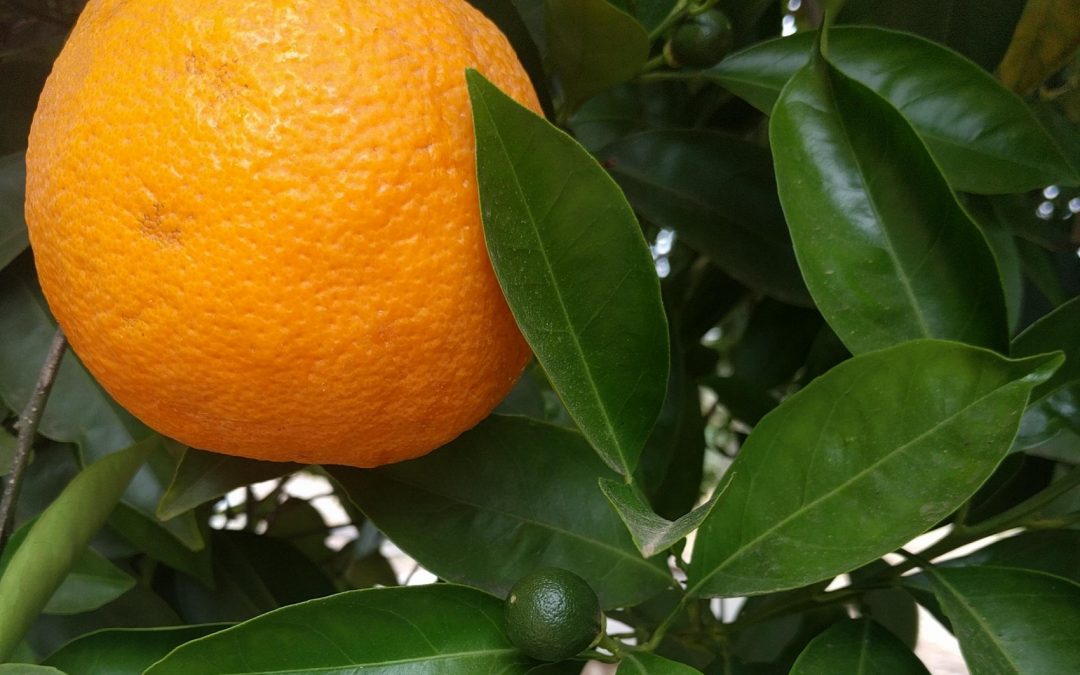
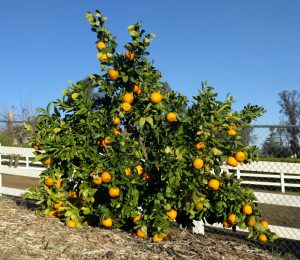
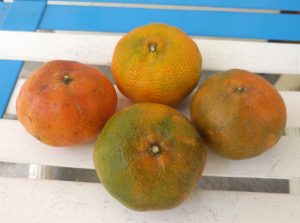
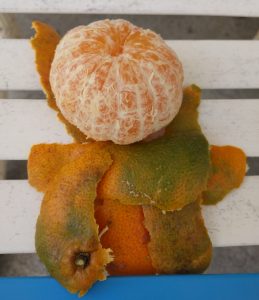
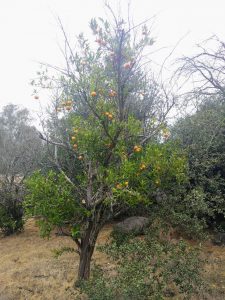
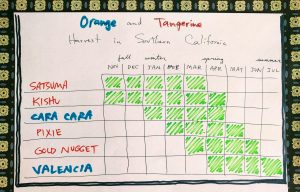


Great, timely post.
Do you prune the large plum trees?
Hi Pat,
Which large plum trees?
Hi Greg, does the pixie reliably start ripening in February for you? UCR listed it at ripening between Nov-Jan, but found that most online places seem to disagree with that.
I just planted a kishu, Cara Cara, and pixie. I have room for another seedless variety, but am debating between tango or gold nugget. What do you suggest if I have a gap between my three current varieties?
I also have Meyer, eureka, and bearss for cooking purposes. Thanks.
Southern California zone 10a
Hi Tin,
That’s weird that the Pixie page on the UCR Citrus Variety Collection website lists November to January as its harvest season. I’ve even eaten Pixies from a tree at the Variety Collection in Riverside in March that tasted great. From my own Pixie tree, they’ve never tasted very good until February at the earliest, but really March is the month that I reliably start picking them. Incidentally, on that same page at the UCR website it says, “Pixie matures in late winter and holds exceptionally late on the tree.” My guess is that they made a mistake with the Nov-Jan listing.
I think you selected your varieties perfectly in order to avoid gaps. Kishus will start, then Cara Caras, and soon after the Pixies. Yet, adding either Tango or Gold Nugget wouldn’t disappoint; those are both excellent varieties. Tango’s harvest is earlier than Gold Nugget.
Old orange tree Dry fruit. I’m on the coast near San Luis Obispo. Bought a house with an established, unknown variety orange. The previous owners kept it to about 5 ft but the trunk is 8 inches the previous owners lived here 30 yrs. the fruit is not peelable. We cut them into quarters. Thing is they have been dry. Got a big harvest this year but the fruit hasn’t improved. Was going to remove it, then found your blog. Do trees get old and tired?
Hi Alan,
Are the oranges dry now? Are you eating them this time of year? If they’re navels, they shouldn’t be drying out yet; they should taste very good about now (late winter).
Are they sweet? Might the tree be a rootstock variety (e.g. sour orange)?
Citrus trees do get old and decline eventually, but as far as I know their fruit doesn’t necessarily decline in quality as they age. (In fact, many people say citrus fruit continually improves as the tree ages.) I’ve eaten from some very old citrus trees whose fruit taste excellent.
We bought our house 3 yrs ago. How do we know what kind of orange trees we have? They look amazing right now, in Folsom, CA zone 9, but are SOUR. there is a tree with oranges a little larger than a golf ball. One tree that looks like mandarin and one that looks like a standard orange. Also, the one with the really small oranges, (think cuties like they sell in the stores) that had branches that blanched out like sand color and lost leaves, BUT at the end of the branch, produced the oranges. We trimmed back some of the dead looking wood, but not all of it. Do you know why this happened? The other two, right next to it, are gorgeous and healthy. Thanks!
Hi Karen,
Your oranges might be sour because they’re immature. My navel oranges don’t taste truly sweet until about February. My Valencia oranges don’t taste truly sweet until about May.
The dieback on the branches could have happened for many reasons. If a tree isn’t watered enough for a long time it will die back like that. Old trees with root or crown diseases can also do that.
There are two main kinds of oranges: navels and Valencias. The easiest way to tell between them is to look for a navel at the bottom of the orange. See photos of navels here: https://citrusvariety.ucr.edu/citrus/washington.html
Hello Greg, this is my first visit to your great blog. I was surprised and pleased to find you are still posting in 2019! I am in the west San Fernando Valley where it is crazy hot–what mandarin will survive here and ripen sweet fruit? I can only have one, so I don’t want to choose wrong!! There is an old Valencia-type orange tree in the yard that is doing very well, if that helps. Thanks!
Hi Rachel,
Yes, indeed. Still alive and posting here in 2019. Hoping that I can maintain this website in the long term because I think it gets more useful the longer I do it.
Good news for you: mandarins love the heat of the San Fernando Valley. I grew up in the San Gabriel Valley, and mandarins love the heat there too.
Your real dilemma is in choosing a variety because there are so many good ones. Start by reading my post about the mandarins I have chosen for my yard: https://gregalder.com/yardposts/oranges-and-mandarins-fresh-off-the-tree-almost-all-year/
Let me know if you’re still having trouble choosing a variety after that.
Hi Greg,
I love your posts! I’ve used you harvest charts to recently add to my backyard avocado and citrus collections to get fruit almost all year.
I would like to add a blood orange and a red or pink grapefruit to the citrus group. I never thought I liked grapefruit, having grown up in the midwest where any grapefruit they sold in the stores needed about a pound of sugar to make it palatable. But I’ve recently tasted some locally grown fruit that was sweet and delicious without all on its own. I’m sold on getting an Oroblanco, but I’m thoroughly confused about which pink or red grapefruit will sweeten up where I live (4S Ranch). Most of the information I’ve read distinguishes coast from inland, but I’m in between. Here it is usually 5-10 degrees hotter than LaJolla, and 5-10 degrees cooler than Poway, Escondido and Vista and we haven’t had frost since I’ve lived here (17 years). The names are also confusing – Rio Red, Ruby Red, Star Ruby, Texas Star Ruby, etc. – seems like the descriptions for a variety in one catalog or web site matches a different variety in another catalog. Could you do a post on the varieties pink and red grapefruit that get sweet in different areas of San Diego County? Thanks!
Hi Jane,
Thanks! Oroblanco and Melogold are mellower, sweeter grapefruits that I like too — except that they aren’t truly grapefruits: they are grapefruit-pummelo hybrids developed at U.C. Riverside.
As for a pink or red grapefruit that will sweeten up in 4S Ranch, I wouldn’t hesitate to try any of the Ruby or Red varieties. I’ve had Ruby Red grown in a location a little hotter than yours, and it tasted good. I’ve been told that Star Ruby and Rio Red can also sweeten up satisfactorily in your level of heat.
But the key, no matter what the variety, is leaving the fruit on the tree for a long time. Every grapefruit will taste sour if picked early in its season, even if grown in extreme heat. And every grapefruit that I’ve tried that has been grown at least a couple miles away from the beach in Southern California can get sweet enough if just left on the tree long enough.
My neighbor has a couple Foster Pink grapefruit trees, and she lets them hang forever on the tree until they taste like Juicy Fruit gum. They end up tasting so sweet that they seem artificial. My kids love them. But we are in Ramona with a bit more heat than you.
HNY Greg! I had what I thought was a failing mandarin tree, had 6 fruit the previous year and 1 this year so I figured it was time to pull it up and try another one (was going to get a Satsuma). I ended up cutting off it’s water supply during the summer and a lot of the branches died and dropped a lot of leaves but now that the rains have come it has completely restarted with vigorous new growth and all the growth has mini blossoms on it. Looks like an entirely new tree now… which I supposed it kind of is. Shot a video if you’re curious. Hope you have a great growing year! I tried for the very first time from my very own trees… my first fig, my first passion fruit and my first dragon fruit. I really like the passion fruit and hope I have an abundance this year. Fig was ok, probably not good as it was from a 1st year tree that I allowed one fruit to mature on. I tried a store bought dragon fruit once and was really disappointed but the one I grew was quite tasty. Looking forward to more of everything this year! Also picked up a manila mango to add to my collection.
Hi Zen,
Good to hear from you. I’ve had similar experiences with some old citrus trees in my yard. One was a mandarin about the size of the one in your video.
Sounds like you’re still having fun out there in the yard. I wish you many passion fruits in 2020!
Gardening is good therapy. Used to love playing turn-based video games and stuff where you upgrade your character and make him stronger and better. Growing stuff is the ultimate turn-based game!!! Hope you’re making headway with your mangos… cya around sometime, maybe I’ll catch you at a gardening event or seminar.
I agree, Zen. I once lived in an apartment for about nine months and had no garden and it was very stressful!
Hi Greg, we purchased a home in Henderson Nevada 3 years ago and in the front courtyard there was a small fruit tree. The yard care team said the tree was dead and offered to remove it. I told them to leave it, I routed water to the tree and added fruit tree fertilizer stacks in the ground around the tree. The first year we got 2 oranges or mandarins the we picked in December but they were very sour. This year the small tree has a lot more fruit. We are trying to figure out what type they are and when they might be ready to pick. We weren’t aware that they might not be ready until Jan through mar. Our night time temps are hitting as low as 38deg but generally stay around 45deg. The fruit looks to be doing good so we’ll hold off until they taste better. My real question may be a dumb one but what is the best for the tree when we do pick them. Pluck it from the tree or clip it close to the fruit. Does either way help or hurt the tree to produce more or less fruit next year. Thank you
Hi Dee,
I would first do my best to make sure that the fruit you are picking isn’t rootstock fruit. For more on this, see my post “Beware of rootstock suckers on citrus trees.”
If it’s rootstock fruit, then it will never taste good, unfortunately.
I like that last question — not a dumb one at all. The tree’s future production isn’t affected by how you pick its fruit, provided you don’t yank off a bunch of branches while picking. For some citrus trees it’s easy to pull the fruit off while keeping the stem intact (Valencia and navel oranges, for example), but for others the stem often remains on the tree and rips a hole in the top of the rind of your fruit (Satsuma mandarins, for example). So if you want to pick Satsuma mandarins but you don’t want to eat them immediately, it’s good to clip them off so they stay fresh longer.
Hi Greg,
You’ve been helpful with my Fuerte avocado questions, and I was thrilled to find this post. I’m not sure if you ever encountered a young gold nugget that the fruit got too heavy for the size of the tree/branches. I picked up a 15g (supposedly semi dwarf) size tree this fall, and it was loaded with so much fruit it seemed inevitable that the branches wouldn’t be able to hold the fruit as it got toward maturity. Preemptively I picked some off, but the rain storms around Thanksgiving, and then around Christmas snapped a few branches with fruit. My question is whether it’s best to prune the branches off, or will the fruit continue to mature even if it’s snapped. In general is there a good pruning technique/ etiquette for dealing with young mandarin trees that get too much fruit? Interestingly enough, my young bearss lime/ eureka lemon trees don’t seem to mind holding as much fruit.
Thanks as always!
Hi Paul,
I’d guess that the fruit attached to the snapped branches will still mature. If the leaves near the fruit (after the area of snapping) are still green, then they’re getting fed and so is the fruit.
The common practice is to prune or thin fruit early after fruitset, like in late spring or early summer, as necessary in order to reduce the crop load in an “on” year. Doing this helps prevent limbs breaking and is said to reduce the alternate bearing that mandarins can fall into where they have a heavy crop followed by a light crop and so on.
My own Gold Nugget has alternated between heavy and light crops the last few years. This year is a heavy crop so I expect next year to be light. I don’t mind this so I don’t do any pruning or fruit thinning to reduce it, but I would if I wanted to try to even out production.
My Gold Nugget tree is also big enough to hold a heavy crop without breaking any or many limbs, but I have thinned a few fruit here and there on limbs that are obviously in danger of breaking once the fruit gets full size.
Sometimes for a young mandarin tree it’s best to just remove fruit at any time where it looks like it’s going to snap a branch, but I’ve rarely done this because citrus wood is flexible in general and often the branch will flex until the fruit rests on the ground and is therefore supported.
I’ve also seen lemon trees with ridiculous amounts of fruit on single limbs without breaking. It’s incredible how much they can handle!
Thank you Greg for this column on when to pick citrus. I look forward to your weekly posts.
I appreciate your taking the time to write this, Lisa. Thank you.
Hi Greg, This is the first time I have found your blog. I live in Tucson, AZ and have 4 citrus trees in my yard. I have not idea the variety of orange, 2 different ones, 1 white grapefruit with very thick skin and very, very juicy and sweet and a tangerine that is dripping with fruit. We feed on a 3x per year schedule that is recommended by the University of Arizona and seems very consistent with other recommendations, Valentine’s Day, Memorial Day and Labor Day. They are starting to bud and we are wondering if we should get the fruit off the trees to allow the new blossoms to take the nutrients.
Hi Barbara,
I wouldn’t harvest your fruit earlier than you want to eat it. The trees should have no problem both holding mature fruit and blooming and setting new fruit. I’ve got a couple of late or year-round type citrus varieties (Valencia orange and Bearss lime) that hold mature fruit through spring while the trees are blooming and growing new fruit, and they produce abundantly year after year.
Thanks! This is great post. I am on the La Mesa/San Diego border. I inherited a “dead mandarin” (dwarf) from a friend. I somehow nursed it back to life. Last year, I had two fruits, but when I picked them in the late spring, they weren’t very sweet–not bad but not great. This year I have 7 but have been waiting. Given the plant is about 2′ tall and the fruits are relatively large, I am wondering if it’s a golden nugget or even a Valencia on dwarf root stock–your sharing really helped me realize there is quite a range. I also thought all of the blossoms were knocked off before they were pollinated with the early April downpours we had, but I noticed 4 babies today!
That’s an awesome find, Shay. I’ve been all of a sudden noticing some fruit on my citrus trees too. It’s like they are invisible until they get as big as golf balls.
Greg, can you advise me if I should prune some of the many branches coming from the base of our tangerine tree? There are 6. And how many branches should come off each branch as it divides?
I just picked the last fruit, and wd like to take care of the tree.
Hi Elizabeth,
There are no rules here, other than making sure that the branches are not coming from below the graft union: https://gregalder.com/yardposts/beware-of-rootstock-suckers-on-citrus-trees/
It all depends on whether you want the plant to look more like a tree or a bush. If you want it to be bush-like, then leave the low branches. If you want it to be tree-like, then cut some off each year as the plant grows taller. I grow some of my citrus in both styles.
I really appreciate your wealth of knowledge that you share here! I thought of your blog when searching for information on tangerine trees and coincidentally this post popped up. I still haven’t found the answer to my question – though – I scrolled through comments quickly and may have missed it: we have an old tangerine tree and the fruit rarely falls from it and now it is full of old fruit. We rarely eat them – they are so tasty, but they have so many seeds it never seems worth the effort to eat them, sadly. Just wondering if it matters for the health of the tree if the old fruit isn’t removed. – thanks!
Hi Stacey,
I don’t think so. You may find people suggesting that you remove old fruit in order to remove sites for buildup of diseases that affect the fruit, but especially if you’re not eating the fruit anyway, then I can’t see the point.
I am in inland (hot) Northern California. I have a ten year old Clementine. Last season it produced close to 300 wonderful tangerines. This year there are maybe two on the tree. Pretty much the same thing happened two years ago. Do tangerines typically alternate years for best production?
Hi Dan,
Yes, this is fairly common. It seems most common on older trees.
My mandarin trees’ production fluctuates but most of them don’t do so severely. However, they are all eight years old or younger.
A mandarin tree at my grandparents’ house, however, alternates much more. It is over 30 years old.
What often happens is that one year will be especially conducive to high fruit production — through ideal weather, bee activity, pollenizer trees nearby, etc. — and then the tree will take the following year off in order to recover. Or the opposite will occur, where a bad weather event like a freeze might hit and cause the total loss of a year’s crop. So then the tree blooms like crazy and sets a huge crop the following year, thus starting a cycle of alternation.
This happens to mandarins, all citrus, and even all other types of fruit trees.
Here in Japan, there are early “wase” varieties which become sweet on the tree and can be eaten when picked, but there are also later “unshiu” varieties that are thicker skinned mandarins meant to be stored for a month or more. We eat them all winter. It takes about a month for the “unshiu” varieties to convert the acidity to sugar in storage. Then they become really sweet – sweeter with more depth of flavor than the earlier “wase” types. But, you wouldn’t want to eat those sour things right off the tree!
Thank you, Cynthia. I’d love to learn more about this. Two things confuse me:
1. Terminology- I’ve eaten some varieties with “wase” in the name, such as Miho Wase, but these varieties are all given the botanical name Citrus unshiu. Could you mention the name of an “unshiu” variety?
2. Would an “unshiu” variety get just as sweet if the fruit were left to sweeten on the tree rather than picked and allowed to sweeten off the tree? Or is there a different reason for wanting to sweeten these varieties off the tree?
Thanks for your help with this!
Great questions, and I confess I had to consult the Japan Agricultural Extension Service to get better information. Apparently, citrus fruit in general transpire oxygen through their peels, with more transpiration happening at warmer temperatures. As they transpire, they convert citric acid to sugars, so sour fruit over time can become sweet. But, that doesn’t really answer your question, does it? It might actually be a cultural practice to remove the fruit from the trees and put into cold storage (usually outdoors in a dark place) to slow down the transpiration. This would enable the home farmer the ability to extend the time period for being able to eat the harvest without it going bad. You take a few out of sold storage and leave them on the counter to eat over a few days, and that hastens the transpiration. “Wase” is a Japanese name for “early”, and those varieties have thin skins that don’t store well, and they don’t develop the acidity that the later “unshiu” varieties do. (You are right, it translates the same. And, yet, everyone uses the common vernacular of wase for the earlies and unshiu for the late, mostly because the unshiu name comes from a Japanese sport of the Chinese Wenzhou variety that became the popular domestic cultivar. The “wase” ,or Wenzhou cultivars come from that city in China, and some famous varieties are Okitsu and Miyagawa, A traditional unshiu, or late, thicker-skinned storing variety would be “Otsu No. 4” or “100,000”. I doubt the names familiar to me would be recognizable by the same name in the U.S., but the early wase are all harvested from September to November, and the Unshiu types that have more acidity but end up tasting much sweeter with storage are harvested here from December into early January. There, I tried my best!
Thank you for the detective work, Cynthia! It’s very interesting for me to hear about the Japanese nomenclature and traditions, along with the Chinese ones.
I’ve heard of people here in California also recommending storing some mandarins before eating them but to me that has never sweetened the fruit, exactly — more like dulled the acidity. But maybe that’s the flavor some people enjoy most.
Thanks again. P.S.- I’ll get my first harvest from a Japanese mandarin variety called Shiranui/Dekopon this winter. Looking forward to it. The fruit is large.
Need advice on a mandarin tree. Beautiful foliage, plenty good sized fruit and colour but so dry inside, inedible. I’m devastated,! Tree is about five feet tall. Any suggestions? Surrounded by various citrus all doing very well.
Hi Bo,
Is it a Satsuma by chance? Those dry out very early. Their season is short compared to many other types of mandarins.
Ok, don’t know the variety. I thoughtsatsuma was a plum. Learned something. Thanks for your time to reply. 😎
I couldn’t find how to comment on your CRFG article on Citrus, Ants and HLB, so I decided to post it here. You addressed the challenge of ants and HLB. I have a solution I’ve found to be very effective in quickly eliminating ants in the house. This can probably be used outdoors, also, as long as you find a way to keep it dry. The solution is a mix of agricultural diatomaceous earth and boric acid, using more diatomaceous earth than boric acid. The ants take it back to their home, and the entire colony dies. Hope you find it helpful.
Thank you for your insight regarding oranges and the ripening process.. Your description of
the process is very helpful and consistent with what I have experienced.
Sure glad I read this! I will now be picking an orange (washington state variety) off my new tree a couple weeks after it has turned orange, to be safe. Sadly, I only have 2 that stayed on the tree and want to try to get it right the first time around.